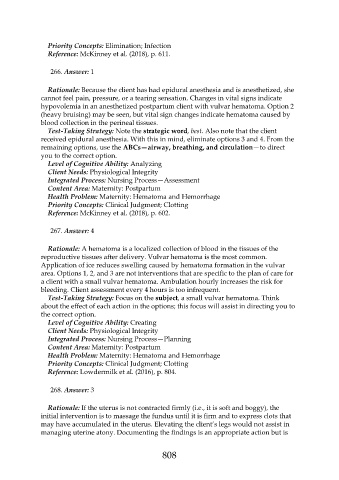Page 808 - Saunders Comprehensive Review For NCLEX-RN
P. 808
Priority Concepts: Elimination; Infection
Reference: McKinney et al. (2018), p. 611.
266. Answer: 1
Rationale: Because the client has had epidural anesthesia and is anesthetized, she
cannot feel pain, pressure, or a tearing sensation. Changes in vital signs indicate
hypovolemia in an anesthetized postpartum client with vulvar hematoma. Option 2
(heavy bruising) may be seen, but vital sign changes indicate hematoma caused by
blood collection in the perineal tissues.
Test-Taking Strategy: Note the strategic word, best. Also note that the client
received epidural anesthesia. With this in mind, eliminate options 3 and 4. From the
remaining options, use the ABCs—airway, breathing, and circulation—to direct
you to the correct option.
Level of Cognitive Ability: Analyzing
Client Needs: Physiological Integrity
Integrated Process: Nursing Process—Assessment
Content Area: Maternity: Postpartum
Health Problem: Maternity: Hematoma and Hemorrhage
Priority Concepts: Clinical Judgment; Clotting
Reference: McKinney et al. (2018), p. 602.
267. Answer: 4
Rationale: A hematoma is a localized collection of blood in the tissues of the
reproductive tissues after delivery. Vulvar hematoma is the most common.
Application of ice reduces swelling caused by hematoma formation in the vulvar
area. Options 1, 2, and 3 are not interventions that are specific to the plan of care for
a client with a small vulvar hematoma. Ambulation hourly increases the risk for
bleeding. Client assessment every 4 hours is too infrequent.
Test-Taking Strategy: Focus on the subject, a small vulvar hematoma. Think
about the effect of each action in the options; this focus will assist in directing you to
the correct option.
Level of Cognitive Ability: Creating
Client Needs: Physiological Integrity
Integrated Process: Nursing Process—Planning
Content Area: Maternity: Postpartum
Health Problem: Maternity: Hematoma and Hemorrhage
Priority Concepts: Clinical Judgment; Clotting
Reference: Lowdermilk et al. (2016), p. 804.
268. Answer: 3
Rationale: If the uterus is not contracted firmly (i.e., it is soft and boggy), the
initial intervention is to massage the fundus until it is firm and to express clots that
may have accumulated in the uterus. Elevating the client’s legs would not assist in
managing uterine atony. Documenting the findings is an appropriate action but is
808

